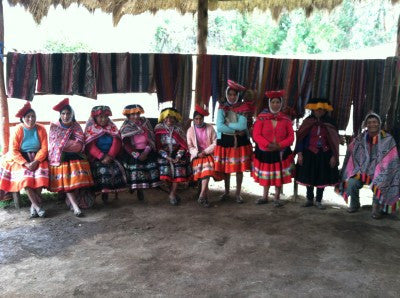Our work - preserving the ancient practice of Peruvian weaving - provides economic opportunity to women who traditionally did not have any income. Through our dedication to fair trade and transparency, we have established relationships of mutual support and respect. But perhaps our most important efforts are focused on supporting these communities through social projects that increase the knowledge base of the weavers and improve access to quality healthcare and education for their families.
That is why we have paired up once again with Apus Peru to develop one-day weaving and natural dye workshops for tourists to visit the Rumira Sandormayo community. Not only do these workshops support our goal of educating the world about the Andean people and the importance of their weaving tradition but they also generate greater income to the women and their families.

Rumira Sandormayo weaver, Virginia Medina Mamani, receives a showering of white flower petals from one of her Amaru hosts.
Realizing our goal of education, on behalf of the visitors and the weavers, is a bit more complicated than just arranging the date and transportation for workshops. And that is why our other goal, that of support and capacitation, plays such an integral part in the development process. To prepare the women and ourselves to receive foreign visitors to their communities, we organized a sustainable tourism workshop with the weaving association from the Amaru community. Amaru is located near to the popular tourist village of Pisaq and has many years of experience working with foreign tourists. Early one Friday morning in April, our team climbed aboard the Apus van for the three-hour drive to Rumira, picked up the five weavers designated as ambassadors for the weaving association and set off together for another two hours drive to Amaru.

Matiaza Quispe Medina chats with the Amaru women about the weaving techniques, pallays (designs) and colors seen in the textiles on display.
It was really an experience to watch as the women bloomed over the course of the day - shy and reserved at first, then curious and outspoken by the end of the day. We were greeted warmly by the other weavers and community president, Gregorio, with introductions and their charming tradition of placing flowers petals on guests’ heads. What followed was truly an amazing afternoon - a four-course meal (appetizer to dessert, no joke!) prepared in the most basic conditions, discussion about tourism and receiving foreign guests, sustainable agriculture and finally, time for questions about the beautiful textiles on display for us. The weavers of both communities were the focus, keeping up the conversation and chatting amongst themselves. Although us non-Quechua speakers didn’t understand much, there is no doubt that the day was a great success!

The diversity and vibrancy of the Amaru textiles were more than enough to distract me during the weavers' discussions in Quechua!

Our cheerful tagalongs for the afternoon, Roxyra and Benjamin, smiling for the camera.
Perhaps it strikes you as strange that so much work would go into one or two hours of weavers talking about weaving. But the remoteness of these villages, as well as the reserved personalities of the women, make it challenging to interact with chatty, smiling tourists from around the world. The time and effort that we invest in capacitation workshops will ensure that these experiences are not only mutually beneficial to the community and their foreign guests, but that we continue supporting education about the beautiful diversity of world cultures.

